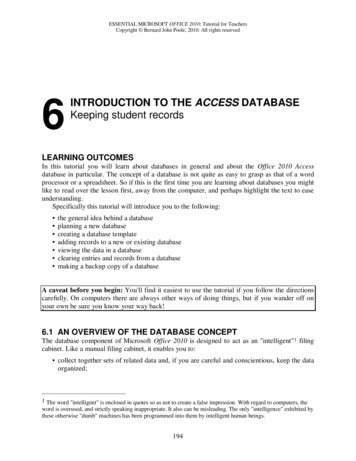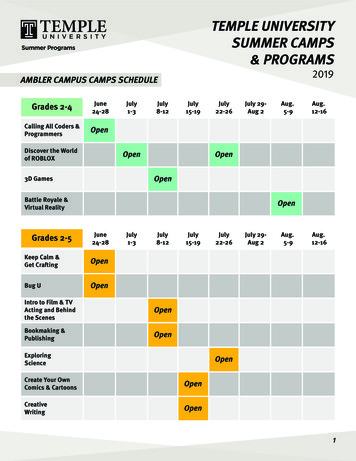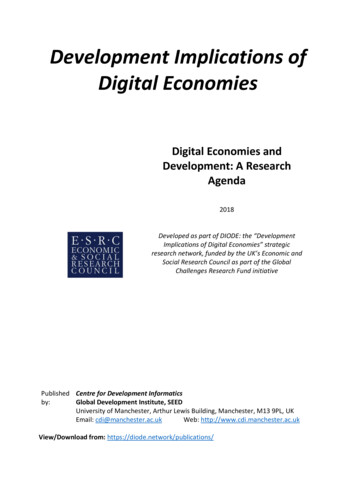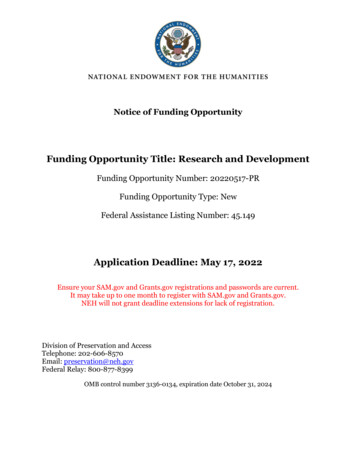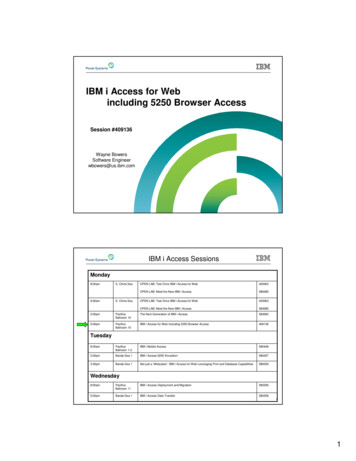
Transcription
Abetz et al. Health and Quality of Life Outcomes 2011, en AccessDevelopment and validation of the Impact of DryEye on Everyday Life (IDEEL) questionnaire, apatient-reported outcomes (PRO) measure for theassessment of the burden of dry eye on patientsLinda Abetz1*, Krithika Rajagopalan2, Polyxane Mertzanis3, Carolyn Begley4, Rod Barnes5 and Robin Chalmers6, forthe impact of dry eye on everyday life (IDEEL) Study GroupAbstractObjective: To develop and validate a comprehensive patient-reported outcomes instrument focusing on theimpact of dry eye on everyday life (IDEEL).Methods: Development and validation of the IDEEL occurred in four phases: 1) focus groups with 45 dry eyepatients to develop a draft instrument, 2) item generation, 3) pilot study to assess content validity in 16 patientsand 4) psychometric validation in 210 subjects: 130 with non-Sjögren’s keratoconjunctivitis sicca, 32 with Sjögren’ssyndrome and 48 controls, and subsequent item reduction.Results: Focus groups identified symptoms and the associated bother, the impact of dry eye on daily life and thepatients’ satisfaction with their treatment as the central concepts in patients’ experience of dry eye. Qualitativeanalysis indicated that saturation was achieved for these concepts and yielded an initial 112-item draft instrument.Patients understood the questionnaire and found the items to be relevant indicating content validity. Patient input,item descriptive statistics and factor analysis identified 55 items that could be deleted. The final 57-item IDEELassesses dry eye impact constituting 3 modules: dry eye symptom-bother, dry eye impact on daily life comprisingimpact on daily activities, emotional impact, impact on work, and dry eye treatment satisfaction comprisingsatisfaction with treatment effectiveness and treatment-related bother/inconvenience. The psychometric analysisresults indicated that the IDEEL met the criteria for item discriminant validity, internal consistency reliability, testretest reliability and floor/ceiling effects. As expected, the correlations between IDEEL and the Dry EyeQuestionnaire (a habitual symptom questionnaire) were higher than between IDEEL and Short-Form-36 andEuroQoL-5D, indicating concurrent validity.Conclusion: The IDEEL is a reliable, valid and comprehensive questionnaire relevant to issues that are specific todry eye patients, and meets current FDA patient-reported outcomes guidelines. The use of this questionnaire willprovide assessment of the impact of dry eye on patient dry eye-related quality of life, impact of treatment onpatient outcomes in clinical trials, and may aid in treatment effectiveness evaluation.Keywords: Dry eye, Sjögren’s Syndrome, non-Sjögren’s keratoconjunctivitis sicca, health-related quality of life, treatment satisfaction, symptoms, impact, patient-reported outcome, questionnaire* Correspondence: Linda.Abetz@mapivalues.com1Mapi Values, Adelphi Mill, Grimshaw Lane, Bollington, Cheshire, SK10 5JB,UKFull list of author information is available at the end of the article 2011 Abetz et al; licensee BioMed Central Ltd. This is an Open Access article distributed under the terms of the Creative CommonsAttribution License (http://creativecommons.org/licenses/by/2.0), which permits unrestricted use, distribution, and reproduction inany medium, provided the original work is properly cited.
Abetz et al. Health and Quality of Life Outcomes 2011, onThe Dry Eye Workshop defined dry eye as a “multifactorial disease of the tears and ocular surface that resultsin symptoms of discomfort, visual disturbance, and tearfilm instability with potential damage to the ocular surface” [1,2]. It is accompanied by detrimental effects onpatients’ health-related quality of life (HRQL) [3-6] andvision-related quality of life [7]. Dry eye or non-Sjögren’s keratoconjunctivitis sicca (non-SS KCS) is a condition due to lacrimal and/or meibomian glanddysfunction leading to diminished production orincreased evaporation of tears [1,8]. It may be associatedwith Sjögren’s Syndrome (SS), which is a systemic autoimmune disorder in which chronic inflammation of thelacrimal and salivary glands, that eventually leads toinsufficient tear production, and the characteristic clinical features of dry eyes and dry mouth [1,9,10]. Thereare two basic forms of SS [1,11]: primary SS, the diseaseby itself that is not associated with any other illness, andsecondary SS, that develops in the presence of anotherautoimmune disease such as rheumatoid arthritis, lupusor psoriasis [1,11,12]. In susceptible individuals, exacerbating factors such as systemic medications thatdecrease tear production or environmental conditionsthat increase tear evaporation may lead to an increase inthe severity of symptoms. Thus, dry eye is a chroniccondition that is heterogeneous not only in aetiology,but also in severity.Multiple studies have shown that clinical tests can bepoorly associated with the changes in symptoms as thedisease progresses and the self-perceived severity of thecondition [13-18], although recent studies have shownhigher correlations with tear osmolarity [18] Other conditions such as allergy, basement membrane disease orconjuntivochalasis could present as dry eye, with symptoms of ocular irritation. Thus, a validated questionnairethat fully assesses symptoms together with the effect ofdry eye on daily life is indicated [4,19,20].Because dry eye symptoms can occur without clinicalsigns of tissue damage, it has been considered a symptom-based condition, especially in mild to moderatecases[1,21]. It is often under-diagnosed relative to thepatients’ assessment [17], particularly among the elderlyand women. An incidence study in the elderly showed a21.6% increase in dry eye over a ten-year period, whichincreased with age and was greater in women [22].However, patients with clear signs of dry eye may reportfew symptoms, perhaps due to sensory damage of theocular surface. Thus, refining patient reported outcomesto track the natural history of the condition, its variability and its effect on daily life becomes critical [18].Some of the common treatment methods for SSinclude artificial tears, anti-inflammatory drugs, andbalanced diet and exercise to overcome pain and fatiguePage 2 of 16[23,24]. Treatment of non-SS KCS is generally confinedto tear film replenishment and stabilization through useof artificial tears, gels and ointments, ergonomic modifications and punctual occlusion [23]. In moderate tosevere non-SS KCS, patients report treatments to be oflimited value [13], and often become frustrated withtheir treatment course, are forced to repeatedly visitdoctors and specialists, and ultimately seek alternativetreatments [25].Multiple dry eye-specific questionnaires exist that aimto assess frequency and severity of the dry eye symptoms or to help in dry eye diagnosis and screening[13-16,26-30]. While the Ocular Surface Disease Index(OSDI) addresses the impact of dry eye on vision-relatedfunctioning and dry eye symptoms in terms of severity,it covers only some of these aspects and is thereforeunlikely to describe the full impact and burden of dryeye and its treatment on patients’ everyday life [6]. Onlythe IDEEL covers all relevant domains of dry eye including dry eye symptoms and dry eye-related quality of lifedomains of the patients’ life that might be impacted (i.e.visual functioning activities, psychological, social andcognitive aspects), as well as treatment satisfaction[4,19,20,31,32].The purpose of this study was to develop and validatea comprehensive patient-reported outcomes (PRO)instrument, the Impact of Dry Eye on Everyday Life(IDEEL) that extensively evaluates dry eye symptomsand all the aspects of patients’ daily life impacted by thecondition and its treatment.MethodsDry eye expert cliniciansDry eye expert clinicians on the team provided expertiseand took part extensively in the decisions throughoutthe process of development and finalisation of the questionnaire. They gave their approval at each of the milestones of the development and finalisation process. Thequestionnaire was also reviewed and agreed by the clinical investigators.Development of the questionnairePhase 1: Patient focus groupsSix focus groups were conducted in the United States(Alabama, California, Indiana and Minnesota) andCanada (Toronto and Waterloo) with non-SS KCS (fourgroups) and SS (two groups) subjects. Patients wererecruited in hospital-based clinics and private practices.Clinical investigators at each study site recruited subjects using the International Classification of Diseases,Ninth revision, Clinical Modification (ICD-9CM) for thenon-SS KCS subjects and the San Diego criteria for SSsubjects (which includes a positive salivary gland biopsy)[33]. To be eligible, subjects had to be aged over 18
Abetz et al. Health and Quality of Life Outcomes 2011, 9:111http://www.hqlo.com/content/9/1/111years and had to have dry eye symptoms in the previousfour weeks; they were excluded if they had a punctualocclusion within the past 60 days or if they had experienced a change in systemic medication regimen withinthe last 30 days. Subjects signed consent forms prior tostudy participation and were compensated for theirtime. The focus groups were performed by trained moderators using an interview guide specifically designed forthe purpose to help moderators lead the discussions,and to ensure conformity across focus groups. Focusgroups were recorded and subsequently transcribedverbatim.Qualitative analysis of transcripts was performed usingmethods derived from Grounded Theory, with patients’quotes coded and organized into themes or concepts[34]. Analysis was performed using Atlas.ti software version 6.2 [35]. To verify adequate sample size and thefull coverage of the research topic, saturation was studied. Saturation is defined as the point at which no newconcepts or information emerge with the addition ofmore patient data [36-38]. Saturation was determined byfollowing concepts and information that arose per focusgroups ranked in the chronological order they wereconducted.Phase 2: Concept elicitation and item generationUsing grounded theory methods, concepts and sub-concepts were elicited from the analysis of transcripts. Allconcepts and sub-concepts mentioned by subjects andrelated to symptoms, daily impact, or treatment satisfaction bother/convenience were included in a comprehensive set of items that were generated to develop theinitial version of the questionnaire.Phase 3: Pilot study/Cognitive debriefingThe feasibility of the pilot version of the questionnairewas subsequently tested in dry eye subjects in the USand Canada in an individual interview setting. Half ofthe subjects in this phase had been involved in the focusgroups and the remaining half was recruited using thesame method as in Phase 1. Subjects completed thepilot version and were questioned regarding their general impressions of the questionnaire; its comprehensiveness; the clarity of the instructions, items andresponse choices; and their interpretations and opinionsof the relevance of each question. Subjects were alsoasked to provide suggestions on how to reword theinstructions, questions and response options.Finalisation, scoring and psychometric validation of thequestionnaireStudy population and designTo participate in the psychometric validation study [13],outpatients subjects had to be at least 18 years old,must have had an eye exam in the past 18 months, anda confirmed diagnosis of either non-SS KCS or SSPage 3 of 16(except for the controls). Five optometrists and oneophthalmologist participated as clinical investigators atsix study sites. ICD-9CM codes and the San Diego criteria (which includes a positive salivary gland biopsy)were used to identify non-SS KCS and SS subjects,respectively [33]. Potential study subjects were screenedby the investigators by telephone, with a series of questions that ensured the presence of dry eye symptoms inthe previous 4 weeks; patients were excluded if theywore contact lenses, had undergone refractive surgery,had a punctual occlusion within the past 60 days, orhad experienced a change in systemic medication regimen within the past 30 days. Control subjects wererecruited from lists of patients who did not have ICD9CM diagnostic codes for dry eye. During the telephonescreening, these subjects had to have responded negatively to the question, “Do you think you have dry eye?”and that they have “never” or “rarely” had dry eye symptoms or used artificial tears. Finally, at least two thirdsof the control subjects recruited had to be older than 35years to ensure the control population characteristicswere as close as possible as the ones of the patients.Subjects also had to be literate in English, willing andable to complete a series of questionnaires twice over atwo-week period and willing to undergo clinical testingfor dry eye as part of the study. Consent forms weresigned by all the subjects prior to study participationand they were all compensated for their time.Eligible patients underwent two visits: a baseline visitand a second visit 2 weeks later. Informed consent wasobtained from subjects at the baseline visit [13].Patient-reported outcome questionnaires and clinicaltestsThe subjects completed the following questionnaires atbaseline and two weeks later, in the following order: thepilot version of the IDEEL questionnaire, the MedicalOutcomes Study Short-Form-36 Health Survey (SF-36) a36-item general measure of health status [39], therevised Dry Eye Questionnaire (DEQ 2001) [27,39,40]and the EuroQoL (EQ-5D), a 5-item general utility measure of health attributes [41]. The DEQ 2001 is a revision of the earlier DEQ questionnaire, which wasvalidated in a large unselected clinical population andagainst dry eye diagnosis [27,40]. Subjects also completed a demographic form at the first visit and the DryEye Change Scale, a 3-item change questionnaire thatassesses change in overall dry eye symptom status, atthe second visit.To try to assess whether there was a relationshipbetween these clinical measures and the PROs measures,the following clinical tests were performed by the investigators during the first visit: Snellen visual acuity, Schirmer 1 tear test, fluorescein tear break-up time, corneal
Abetz et al. Health and Quality of Life Outcomes 2011, n staining, and conjunctival lissamine greenstaining.Page 4 of 16or items in the SF-36, EQ-5D and DEQ were substantially correlated (r 0.40) with the IDEEL [46].Known group validityPsychometric AnalysisConstruct validityThe percentages of subjects from the total study population who chose response options “not applicable” or“none of the time” to the IDEEL items at baseline werereviewed: items with percentages greater than 70% wereconsidered for deletion, as were items with high levelsof missing data ( 20%).Principal components analysis (PCA) with promaxrotation analysis aided in the development of itemdimension structures and item reduction of the pilotversion of the IDEEL [42]. Factors were retained wheneigenvalue was greater than 1 [42]. A threshold for factor loading of 0.40 was fixed for the PCA: items that didnot load well ( 0.40) with their own factor and itemsthat loaded 0.40 on more than one factor were considered for deletion [43]. To be included in the factor analysis, subjects had to have completed all items in eachscale. If patients in the focus groups and content validityindicated an item was important and expert cliniciansalso endorsed the item as relevant to dry eye, the itemwas retained regardless of statistical results.Multi-trait Analysis was also performed to determinethe correlation between each item and the dimension towhich it belonged [43]. The analysis was performedtwice: before and after item reduction. As with the PCAstep, an item was considered for deletion if it did notcorrelate with its own dimension at 0.40 (item convergent validity) or if it correlated higher with a dimensionother than its own (item discriminant validity) [43].Floor and ceiling effects were also investigated for eachof the items.The following properties were assessed on the finalversion of the IDEEL, after item reduction, finalisationand scoring.ReliabilityInternal consistency reliability and reproducibility (’testretest reliability’) were examined. A Cronbach’s alphacoefficient of 0.70 was considered acceptable for internal consistency [44]. Test-retest reliability was evaluatedby examining the Interclass Correlation Coefficients(ICCs) between visit one (week 0) and visit two (week 2)for patients who reported stability in their dry eye symptoms in the previous 2 weeks. An ICC of 0.70 wasconsidered acceptable for test-retest reliability [45].Concurrent validityCorrelations (Pearson coefficients) between the generalhealth measures (SF-36, EQ-5D) and the specific questionnaire DEQ were studied and compared to similardimensions (i.e. covering a same concept) in the IDEEL.Concurrent validity was supported if similar dimensionsKnown group validity was assessed by examining differences in IDEEL baseline scores for groups of patientswith different levels of dry eye severity for each severityassessment method. Three types of severity assessmentswere made during the study: diagnosis severity of thepatients recruited (i.e. control, non-SS KCS or SS), clinician report of severity and patient self-report of severity.Clinical validityThe correlation between the IDEEL and clinical testspreviously listed was examined to assess clinical validity.Statistical analyses were conducted using StatisticalAnalysis Software version 8.2 and Multi-trait AnalysisProgram - Revised software version 1.0 [43]. Analyseswere conducted using parametric tests. For all tests, asignificance level of 0.05 (two-sided) was used unlessotherwise indicated. When reducing the number ofitems in the questionnaire, both statistical results andthe clinical relevance of items were considered prior todeletion.Conceptual frameworkFollowing PCA and Multi-trait analysis findings, thefinal conceptual framework of the questionnaire wasdeveloped with input from clinical experts, and basedon the importance of the concepts and sub-conceptsfrom patients’ perspective.ResultsDevelopment of the questionnaireThe focus groups had 6 to 10 participants in each; thetotal population consisted of 45 patients: 30 with nonSS KCS and 15 with SS. Age ranged from 20 to 79 years(mean age 58 14 years). The majority of the patientswere female (91%), Caucasian (85%), with at least a highschool diploma or General Educational Development(GED) diploma (86%). Time since dry eye diagnosis ranged from 5 months to 25 years. Ninety percent of thepatients self-rated the severity of their dry eye as mild/moderate (58%) or severe (32%). High blood pressureand arthritis were the health conditions other than dryeye most frequently experienced by subjects (22% and20%, respectively).The following concepts and sub-concepts emergedfrom the focus group analysis as relevant to patientsexperience with dry eye: vision-related symptoms andtheir bothersomeness, including burning/heat sensations,dryness/irritation, moisture-related symptoms, painrelated symptoms, tired eyes, eye appearance, swelling,tearing, light/wind sensitivity; daily life impact, includingphysical, daily activities, work, relationships, cognitive,emotions, leisure and social impact, visual-aid impact,
Abetz et al. Health and Quality of Life Outcomes 2011, sleep, appearance/aesthetics and generalimpacts; and treatment experiences and satisfaction interms of inconvenience, effectiveness and frequency.Saturation was achieved for dry eye symptoms andthese symptom sub-concepts, as well as for all of theoverarching concepts of dry eye daily life impact and forthe aforementioned sub-concepts.Concepts and sub-concepts were selected that wereclinically important (as discussed with the dry eye expertclinicians) and also important from a patient’s perspective (as emerged from the focus group discussions). Aninitial 116-item questionnaire was developed that wasorganized around the following modules: dry eye symptom-bother (37 items); dry eye impact on daily life,including impact on daily activities (21 items), emotionalimpact due to dry eye (32 items), impact on work due todry eye (8 items); satisfaction with overall treatment (9items) and satisfaction with eye drops (9 items). Theitems were generated in US English.The questionnaire was subsequently comprehensiontested in 16 subjects (mean age: 63 years; range: 41-79years). The subjects were mainly female (81%), Caucasian (87%) and had at least a high school diploma orequivalent (94%). The 116-item questionnaire was completed in 18.5 minutes on average (range: 11-35 minutes). Overall, subjects expressed positive commentsregarding the questionnaire. Based on their reportedlevels of understanding and their suggestions, minorwording changes were made to the instructions andquestions. In total, two questions were removed, foursets of questions were combined and three questionswere split into six questions, yielding 112 questions andsix hypothesised dimensions as described above. Thisquestionnaire was then fielded in the psychometric validation study.Psychometric validationStudy population demographicsThe demographics of the validation study subjects arepresented in Table 1. The population included 210 adultsubjects: 130 with non-SS KCS, 32 with SS, and 48 controls. The majority of the population was Caucasianfemale and the mean age was 51 years (range: 20-89years). Follow-up pairwise t-tests showed that the groupof controls was significantly younger (39 years) than boththe non-SS KCS (55 years) and SS groups (58 years); thelatter two groups did not differ statistically by age.Item Reduction, descriptive statistics and constructvalidityGiven that dry eye symptom-bother, dry eye impact ondaily life and dry eye treatment satisfaction are conceptually distinct, it was hypothesised that each modulecould be processed as single distinct sub-questionnairePage 5 of 16Table 1 Demographic characteristics of the psychometricvalidation study population (n 210)CharacteristicsControl(n 48)Non-SS KCS*(n 130)SS*(n 32)Sex (n (%))Male13 (27)27 (21)3 (9)Female35 (73)103 (79)29 (91)Age (Year)Mean39.255.258.3Standard 0.0Ethnicity (n (%))Caucasian34 (71)106 (82)31 (97)African-American6 (13)12 (9)1 (3)Hispanic/Spanish-AmericanAsian/Oriental/Pacific Islands5 (10)1 (2)5 (4)6 (5)0 (0)0 (0)Other2 (4)1 (1)0 (0)6 (19)Highest level of education (n (%))High school diploma or less9 (19)23 (18)Some college13 (27)47 (36)8 (25)College degree15 (31)29 (22)11 (34)Graduate/postgraduateOther8 (17)3 (6)31 (24)0 (0)5 (16)2 (6)* Non-SS KCS, Non Sjögren keratoconjunctivitis sicca; SS, Sjögren Syndrome[13][47-49]. PCA was thus conducted on each of these modules separately. The impact on work due to dry eyedimension was both included and excluded from factoranalyses due to smaller sample sizes for the work-relateditems. The analyses mentioned below were conductedon the total study population (n 210).For the Dry Eye Impact on Daily Life module, theeigenvalues obtained with the PCA for the Impact onDaily Activities and Emotional Impact due to Dry Eyedimensions confirmed two distinct dimensions, witheigenvalues 1. For the Impact on Work Scale, theeigenvalues suggested one dimension. Four items didnot load on any of the factors, and were retained asindividual items for conceptual reasons (i.e. items ofimportance for the patients and/or expert clinicians;these items were about wearing contact lenses, wearingmake-up, flying on an airplane and feeling helplessabout dry eye). The Dry Eye Symptom-Bother moduleyielded a single factor, indicating a single dimension.The eigenvalues for the Treatment Satisfaction modulesuggested two dimensions: Satisfaction with TreatmentEffectiveness and Treatment-Related Bother/Inconvenience. Two items did not load on any of the factors, andwere retained as individual items for conceptual reasons(items about treatment frequency).Only the Dry Eye Treatment Satisfaction moduleshowed a floor effect, which was low (5.84% for the
Abetz et al. Health and Quality of Life Outcomes 2011, 9:111http://www.hqlo.com/content/9/1/111total dry eye sample). Ceiling effects were present for allIDEEL modules with the exception of the Dry EyeSymptom-Bother module (0.6%). Acceptable ceilingeffects were evident for the remaining dimensions(14.9% for Impact on Daily Activities, 13.7% for Emotional Impact due to Dry Eye for those who were working, 13.4% for Impact on Work due to Dry Eye and forthose on treatment, 1.6% for Treatment Satisfaction and15.2% for Treatment-related Convenience/Bother.Based on the PCA results, the item descriptive statistics, construct validity and face validity results, a total of55 items were removed from the pilot version of thequestionnaire: 27 items were removed because morethan 70% of the patients answered “None of the time”,“Not at all” or “Not applicable” to items; 1 item wasremoved because 77% of the patients did not answer theitem; 25 items were removed according to the loadingfactor analysis results; and 4 items were combined into2 because they were highly correlated ( 0.90) and had asimilar wording ("burning” with “stinging"; “ache” with“sore”).Thus, the final IDEEL consists of 57 items organisedinto 3 different modules. The Dry Eye Symptom-Bothermodule constituted a single dimension (20 items). A 4point Likert scale was used for all items except “frequency of experience of dry eye symptoms” that wasscored on a 5-point Likert scale. An option indicatingthe symptom was not present was also available. TheDry Eye Impact on Daily Life module was composed of3 dimensions covering Impact on Daily Activities (9items), Emotional Impact due to Dry Eye (12 items) andImpact on Work due to Dry Eye (6 items); 4 individualitems and a working status item were part of the module. A 5-point Likert scale was used for all the itemsexcept “work status” that was scored on a dichotomous“Yes” or “No” scale. The Dry Eye Treatment Satisfactionmodule was composed of two dimensions coveringSatisfaction with Treatment Effectiveness (6 items) andTreatment-Related Bother/Inconvenience (4 items); the2 individuals items were part of the module. A 5-pointLikert scale was used for all the items except “eye dropuse”, that was scored on a dichotomous “Yes” or “No”scale. The questionnaire was named IDEEL: Impact ofDry Eye on Everyday Life. The conceptual framework ofeach of the three modules of the questionnaire isdescribed in Figure 1, Figure 2 and Figure 3.Scores for each dimensions ranged from 0 to 100.Higher scores for the dimensions of the Dry Eye Impacton Daily Life module indicated less impact on dailyactivities, work and emotions; higher scores for theSymptom-Bother dimension indicated greater botherdue to symptoms; higher scores for Satisfaction withTreatment Effectiveness dimension indicated greatersatisfaction with treatment effectiveness; higher scoresPage 6 of 16with Treatment-related Bother/Inconvenience indicatedless treatment-related bother or inconvenience.Item convergent validity/discriminant validityAll items of the “Emotional Impact due to Dry Eye”,“Symptom-Bother” and “Satisfaction with TreatmentEffectiveness” met the discriminant validity criteria (eachitem should correlate higher with its own dimensionthan with the other dimensions).ReliabilityThe internal consistency and test-retest reliability resultsfor the IDEEL are presented in Table 2. Internal consistency reliability was good (Impact on Daily Activities,Impact on Work; Satisfaction with Treatment Effectiveness) to excellent (Dry Eye Symptom-Bother; EmotionalImpact). Although the Treatment-related Bother/Inconvenience Scale only just surpassed the reliability criterion with a Cronbach’s alpha of 0.70, this indicatesstrong internal reliability as the scale consists of 4 fairlyheterogeneous items. All the dimensions of the IDEELshowed good test-retest reliability, ICC ranging from0.70 to 0.88.Concurrent validityCorrelations between the IDEEL and SF-36 and EQ-5Dwere low across the majority of dimensions (ranges:0.04-0.45 and 0.09-0.36 respectively), as expected (Table3). In contrast, the dimensions of the IDEEL were morehighly correlated with the items of the DEQ (range:-0.05-0.83), indicating the concurrent validity of theIDEEL (Table 3). The strength of the associationsbetween the IDEEL dimensions and DEQ items was asexpected. In general, the IDEEL dimensions were mosthighly correlated with items pertaining to eye drynessand eye discomfort. The Dry Eye Symptom-Bother module of the IDEEL was the dimensions most highly correlated with all of the DEQ items (0.21-0.83). All theIDEEL correlations showed the lowest correlations withthe item “DEQ Watery eyes: Frequency in the pastweek” (-0.05-0.21).Known group validityDifferences between severity groups were assessed bypatient-recruited diagnosis (control, non-SS KCS andSS), clinician report of symptoms (none, mild, moderateand severe) and patients’ self-rating of severity ("don’thave dry eye,” “very mild/mild dry eye,” “moderate dryeye” and “severe/very severe dry eye”). For the analysis,the very mild and mild groups were collapsed, as werethe severe and very severe groups. For the Satisfactionwith Treatment Effectiveness Scale, there was no “don’thave dry eye” group, as patients without dry eye symptoms did not complete this section of the questionnaire.
Abetz et al. Health and Quality of Life Outcomes 2011, 9:111http://www.hqlo.com/content/9/1/111Page 7 of 16Figure 1 Conceptual framework of the final version of IDEEL: Dry Eye Symptom-Bother module.Significantly differen
Multiple dry eye-specific questionnaires exist that aim to assess frequency and severity of the dry eye symp-toms or to help in dry eye diagnosis and screening [13-16,26-30]. While the Ocular Surface Disease Index (OSDI) addresses the impact of dry eye on vision-related functioning and dry eye symptoms in terms of severity,

